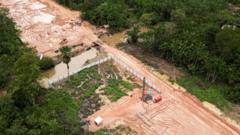The construction of a new four-lane highway cutting through the Amazon rainforest has locals and conservationists reacting with anger as Brazil prepares for the upcoming COP30 climate summit in Belém. This massive roadway, intended to manage the influx of over 50,000 attendees – including world leaders – by easing traffic, has raised alarms about its sustainability and environmental repercussions.
State officials are marketing the Avenida Liberdade as a "sustainable highway," despite the stark reality that it involves clearing tens of thousands of acres of protected forest. Critics argue that this act not only contradicts the underlying goals of the climate summit, which is to promote environmental preservation, but also threatens the ecosystem vital for biodiversity and carbon absorption.
Witness accounts from locals like Claudio Verequete illustrate the toll on communities dependent on the natural resources of the forest; he mourns the loss of income from açaí berry harvesting after the once-lush land became desolate. With no compensation offered, he fears that the road will lead to further exploitation of the area.
Environmental experts express deep concerns over the proposed wildlife crossings and mitigation strategies promised by the state government. According to Prof. Silvia Sardinha, the construction compromises the habitat of wildlife and disrupts natural migration patterns, endangering species already vulnerable to human-caused injuries.
Although officials assure that this infrastructure will eventually serve the greater good, there are increasing doubts about the inclusivity of such developments. While the government touts a vision of modernization for the city, critics argue that the voices of local communities are being marginalized in discussions meant to address their futures.
Infrastructure projects ahead of COP30, such as expanding airport capacity and developing a new city park, come with a hefty price tag of over $81 million. Many residents, reflecting mixed sentiments, remain hopeful the summit will stimulate real change and economic growth, though they voice concerns about the environmental cost of such development.
With scrutiny growing surrounding the environmental footprint of hosting the summit itself, attendees will face difficult questions about their commitment to climate health while engaging in a dialogue from a city grappling with its own environmental crises. The hope remains for COP30 to lead to substantive actions that can foster both community welfare and ecological sustainability in the Amazon.
State officials are marketing the Avenida Liberdade as a "sustainable highway," despite the stark reality that it involves clearing tens of thousands of acres of protected forest. Critics argue that this act not only contradicts the underlying goals of the climate summit, which is to promote environmental preservation, but also threatens the ecosystem vital for biodiversity and carbon absorption.
Witness accounts from locals like Claudio Verequete illustrate the toll on communities dependent on the natural resources of the forest; he mourns the loss of income from açaí berry harvesting after the once-lush land became desolate. With no compensation offered, he fears that the road will lead to further exploitation of the area.
Environmental experts express deep concerns over the proposed wildlife crossings and mitigation strategies promised by the state government. According to Prof. Silvia Sardinha, the construction compromises the habitat of wildlife and disrupts natural migration patterns, endangering species already vulnerable to human-caused injuries.
Although officials assure that this infrastructure will eventually serve the greater good, there are increasing doubts about the inclusivity of such developments. While the government touts a vision of modernization for the city, critics argue that the voices of local communities are being marginalized in discussions meant to address their futures.
Infrastructure projects ahead of COP30, such as expanding airport capacity and developing a new city park, come with a hefty price tag of over $81 million. Many residents, reflecting mixed sentiments, remain hopeful the summit will stimulate real change and economic growth, though they voice concerns about the environmental cost of such development.
With scrutiny growing surrounding the environmental footprint of hosting the summit itself, attendees will face difficult questions about their commitment to climate health while engaging in a dialogue from a city grappling with its own environmental crises. The hope remains for COP30 to lead to substantive actions that can foster both community welfare and ecological sustainability in the Amazon.



















